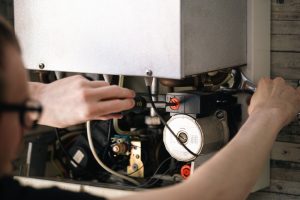Facilities maintenance comprises the upkeep of commercial, residential, or industrial buildings.
Maintenance technicians work to maintain and repair all aspects of the property, from plumbing to HVAC systems, to ensure the equipment and building are well-run and safe for employees and visitors.
Maintenance technicians work in various environments ranging from warehouse facilities and manufacturing to corporate offices and apartment buildings.
Becoming a maintenance technician can be a fantastic career for those who enjoy hands-on work that changes each day.
If you’re interested in becoming a maintenance technician, keep reading to learn more about the steps, licensing requirements, online training programs, and estimated salary!
Steps to Become a Maintenance Technician
Becoming a maintenance technician is rather straightforward but requires completing these six steps:
Step One: Research the Career
While you may have a general idea of the duties of a maintenance technician, it’s important to fully understand the daily requirements to determine if this position is right for you.
Typical daily activities include:
- Assist with the installation of new manufacturing, building, or HVAC equipment.
- Calibrate and adjust machinery to meet specifications.
- Conducting root cause analysis and diagnostic testing to find solutions to equipment issues.
- Disassembling equipment to repair or replace malfunctioning parts.
- Maintain downtime logs.
- Manage the stock of spare parts.
- Order new or replacement parts and tools.
- Preventative maintenance tasks to minimize future issues.
- Properly document preventative maintenance, repairs, and routine checks.
- Respond to alerts and follow corrective action measures.
- Routinely inspect and test equipment.
- Test the machinery to ensure all aspects are running properly.
- Train production staff on routine maintenance.
Step Two: Research a Training Program
The bare minimum to become a maintenance technician is a high school diploma.
After this is earned, most technicians enroll in a certificate program that could take a few months, a one-plus-year diploma program, or a two-year associate degree.
Those who seek future management positions opt for a four-year bachelor’s degree, but this is not necessary to become a maintenance technician.
The longer training programs usually include an apprenticeship to give students firsthand experience in the field, to complement the practical knowledge learned in the classroom.
Step Three: Enroll in a Program
The necessities to become a maintenance technician include attention to detail, proactive problem-solving, technical prowess, manual dexterity, deductive reasoning, and excellent communication skills.
In addition to the textbook knowledge and practical experience gained from a training program, students will also further refine and improve these necessities.
Maintenance technician training programs teach learners how to maintain, repair, troubleshoot, and install complicated electrical and mechanical equipment for manufacturing, building, home maintenance, and HVAC.
Students focus on the critical pneumatic, hydraulic, and electrical functions, the properties of motion, and how different systems integrate and work together.
Also, students are introduced to CAD (computer-aided design) and SolidWorks, which is the standard engineering software within the industry.
Having at least a basic knowledge of SolidWorks and CAD is required for entry-level positions.
Step Four: Enroll in an Internship
In addition to textbook learning, it’s important to enroll in an internship or apprenticeship, so it’s easier to transition into the workforce with minimal training.
Most maintenance technicians are required to complete a year of on-the-job training where they learn how to complete routine tasks and gain firsthand experience with welding, shop mathematics, correct tool use and safety, electronics, computer programming, and blueprint reading.
Step Five: Prepare Your Resume
Once you have gained the necessary skills and experience, you must prepare your resume to find a job.
Always highlight your relevant experience, qualifications, skills, and achievements to show potential employers that you are right for the maintenance technician position.
Many training programs offer graduates career and job support to help you prepare your resume, find opportunities, and prepare for interviews.
Step Six: Apply for Jobs
As more residential, commercial, and industrial buildings are being constructed, the maintenance technician field is booming with opportunity.
Maintenance can range from managing tools and construction equipment to commercial HVAC systems and home maintenance.
Candidates can also work in the food, energy, electronics, construction, and aviation industries.
Some get a job with an established company while others continue their education to gain more knowledge of the craft, resulting in a higher starting salary.
Licensing Requirements to Become a Maintenance Technician
Maintenance technician licensure requirements vary greatly based on the type of maintenance work and the location.
Building maintenance technicians must know local building codes and pass an examination to earn a license, depending on the state.
To do plumbing or electrical work, your state could require licensure in those areas, which also requires coursework, potentially an apprenticeship, and passing an exam.
Although certification is not required, it’s highly beneficial for professionals to join professional organizations or become certified in specialty areas.
These additional credentials open job opportunities and are excellent for networking.
They only require several continuing education hours every couple of years to keep the certification.
Maintenance technicians can earn one of three professional designations:
- Facility Management Professional – offered by the International Facilities Management Association.
- General Industry Certification – provided by the International Maintenance Institute.
- Maintenance and Reliability Certification – designated by the Society for Maintenance & Reliability Professionals.
Online Training Programs
Penn Foster
Penn Foster offers an online Facilities Maintenance Technician Training program that teaches students how to thoroughly inspect, repair, and maintain issues that occur in commercial, residential, and industrial buildings.
The curriculum covers electrical skills, plumbing, HVAC, and foundational workplace safety topics, as well as how to interpret blueprints, a fundamental understanding of tools and equipment, and the basic skills needed for success in the field.
The cost of the program is $1,049, and students have up to 12 months to complete this self-paced curriculum.
SkillCat
SkillCat has an online, self-paced maintenance training program with a curriculum that covers:
- Carpentry
- Construction
- Electrical
- Electrician training
- EPA certification
- HVAC concepts and maintenance
- Maintenance
- Mechanical
- Plumbing fundamentals
- Safety
- Science fundamentals
- Soft skills
Students interested in becoming maintenance technicians will need to focus their coursework on facilities management and building maintenance.
These courses cover OSHA safety standards, blueprint reading, and Computerized Maintenance Management Systems, combined with workshops and practical experience.
The program typically takes between six months and one year, depending on the chosen courses.

Tooling U-SME
Tooling U-SME takes a different approach to maintenance training with a customized curriculum covering maintenance production, electrical production, and maintenance fundamentals.
The goal of the program is to provide enough training for graduates to easily become electrical, automation, mechanical, or production maintenance technicians.
Industry experts developed all classes, and the workload is self-paced to provide the ultimate flexibility for busy students.

TPC Training
TPC offers a maintenance technician training program that includes 90 online technical skills courses, each containing 5-12 detailed, job-specific lessons totaling 616 lessons.
These courses cover topics ranging from reading blueprints and schematics to energy conservation, electrical systems, mechanical systems, material handling, machine shop practices, industrial hazard control, and welding.
While these are online courses, they are instructor-led by top industry professionals who have extensive experience.
Additionally, students have access to 1-4-day instructor-led seminars to further extend their knowledge and skills.
Salary
The median annual U.S. salary for a maintenance technician is $48,620 or $23.38 per hour, with pay ranging from $38,000 to $62,000.
Salaries are heavily dependent on location, experience, type of maintenance work, and size of the employer.
U.S. Average Salary: $52,430
Salary Information by State
| State | Employed | Avg. Annual Salary | Avg. Hourly Pay | Top 10% Annual Salary | Bottom 10% Annual Salary |
|---|---|---|---|---|---|
| Alabama | 16,950 | $44,240 | $21.27 | $62,870 | $28,390 |
| Alaska | 4,540 | $62,490 | $30.05 | $91,260 | $38,110 |
| Arizona | 39,150 | $50,960 | $24.50 | $74,010 | $34,340 |
| Arkansas | 12,770 | $44,000 | $21.15 | $61,620 | $28,820 |
| California | 132,250 | $59,270 | $28.50 | $82,680 | $38,220 |
| Connecticut | 12,690 | $57,420 | $27.61 | $82,420 | $37,140 |
| Delaware | 3,540 | $54,230 | $26.07 | $80,720 | $35,940 |
| D.C. | 4,680 | $62,530 | $30.06 | $82,120 | $41,650 |
| Florida | 112,590 | $48,040 | $23.10 | $66,170 | $32,230 |
| Georgia | 48,440 | $49,000 | $23.56 | $71,190 | $31,200 |
| Hawaii | 7,850 | $57,780 | $27.78 | $79,050 | $36,890 |
| Idaho | 8,780 | $50,170 | $24.12 | $73,430 | $32,880 |
| Illinois | 71,100 | $56,460 | $27.15 | $79,710 | $34,600 |
| Indiana | 34,440 | $52,330 | $25.16 | $74,670 | $33,760 |
| Iowa | 15,720 | $52,760 | $25.37 | $70,580 | $35,360 |
| Kansas | 13,440 | $48,540 | $23.34 | $67,550 | $31,600 |
| Kentucky | 21,370 | $49,000 | $23.56 | $73,920 | $30,060 |
| Louisiana | 22,170 | $46,280 | $22.25 | $72,430 | $25,740 |
| Maine | 5,440 | $51,850 | $24.93 | $73,020 | $36,660 |
| Maryland | 22,290 | $52,830 | $25.40 | $74,260 | $35,990 |
| Massachusetts | 28,170 | $57,600 | $27.69 | $79,100 | $37,910 |
| Michigan | 40,840 | $48,960 | $23.54 | $67,350 | $32,980 |
| Minnesota | 29,960 | $57,350 | $27.57 | $77,640 | $37,650 |
| Mississippi | 13,530 | $44,120 | $21.21 | $68,220 | $25,480 |
| Missouri | 32,210 | $51,360 | $24.69 | $74,190 | $32,050 |
| Montana | 5,430 | $47,960 | $23.06 | $66,060 | $35,360 |
| Nebraska | 9,980 | $50,850 | $24.45 | $65,560 | $35,690 |
| Nevada | 16,100 | $54,720 | $26.31 | $78,800 | $33,760 |
| New Hampshire | 5,540 | $54,480 | $26.19 | $73,690 | $38,330 |
| New Jersey | 34,810 | $55,730 | $26.80 | $80,000 | $36,400 |
| New Mexico | 9,230 | $46,280 | $22.25 | $67,480 | $29,760 |
| New York | 124,640 | $58,290 | $28.02 | $83,600 | $37,120 |
| North Carolina | 46,290 | $49,390 | $23.74 | $68,720 | $32,440 |
| North Dakota | 3,420 | $51,200 | $24.62 | $69,260 | $34,770 |
| Ohio | 63,280 | $53,260 | $25.61 | $74,630 | $33,890 |
| Oklahoma | 20,000 | $44,780 | $21.53 | $64,610 | $28,470 |
| Oregon | 16,940 | $55,220 | $26.55 | $77,350 | $38,260 |
| Pennsylvania | 60,060 | $51,830 | $24.92 | $74,460 | $32,680 |
| Rhode Island | 5,100 | $54,160 | $26.04 | $77,550 | $37,400 |
| South Carolina | 27,820 | $49,370 | $23.73 | $72,620 | $31,040 |
| South Dakota | 3,330 | $47,990 | $23.07 | $61,260 | $36,820 |
| Tennessee | 35,930 | $48,470 | $23.31 | $67,710 | $31,930 |
| Texas | 139,310 | $46,960 | $22.58 | $68,850 | $29,640 |
| Utah | 15,790 | $51,980 | $24.99 | $74,670 | $33,740 |
| Vermont | 2,320 | $56,370 | $27.10 | $74,130 | $40,360 |
| Virginia | 33,610 | $52,980 | $25.47 | $77,840 | $32,040 |
| Washington | 31,960 | $59,640 | $28.68 | $81,490 | $39,730 |
| West Virginia | 8,530 | $44,330 | $21.31 | $67,970 | $26,650 |
| Wisconsin | 30,300 | $53,240 | $25.60 | $74,560 | $34,530 |
| Wyoming | 3,980 | $52,160 | $25.08 | $81,730 | $29,140 |
| Guam | 990 | $31,910 | $15.34 | $42,560 | $22,010 |
| Puerto Rico | 12,540 | $25,350 | $12.19 | $36,840 | $19,760 |
| Virgin Islands | 740 | $43,390 | $20.86 | $61,270 | $28,340 |
* Employment conditions in your area may vary.








